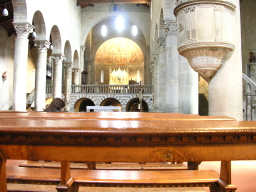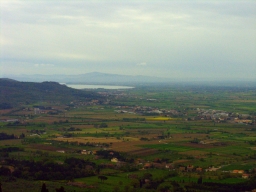
You can enlarge the photos in this page by clicking the mouse cursor on the picture, but you may have to enable popups and javascript to make this work. You can close the new window to return to the main page. If you have Firefox, there is a preference available to allow new pages to open in a new tab rather than a new window, and checking this option will make your viewing experience better. The same option may be present in Internet Exploder versions 7 or higher.
Our first holiday since I had retired. It was a long time since we had been to Cortona - 1987, as far as we could remember. This time you could see Lake
Trasimene.

This is the town hall, which dates from the 13th Century, was on the way to the Etruscan museum.
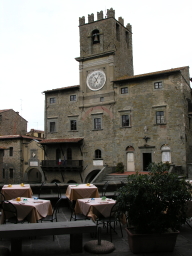
The
musem does not allow photographs :-(( - a pity since the exhibits,
especially the chandelier, were splendid. Same story at the Diocesan
Museum, which has an Annunciation by Fra Angelico, a copy of which
used to hang in our bedroom at Tangmere Close. We were in a hurry to
leave town, because there was a veteran car race due to start on the
street where I had parked. On the way out, we found the church of S
Dominic, which was where Fra Angelico had his studio.
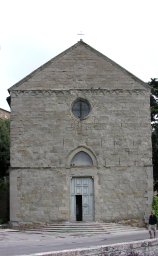
It has a splendid painted altarpiece that goes unnoticed in most guidebooks.
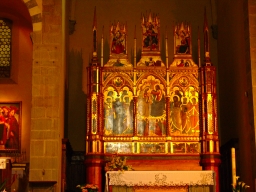
My
Garmin could not find the restaurant we were looking for, because the
Italian Celiac Association website gives such useless addresses. In
the end, we decided to drive towards Farneta, a Benedictine abbey
founded before the year 1000. The Benedictines left in the 16th
Century, and handed the place over to the Olivetans. They left in
1780, and the church was handed over to the Diocese of Cortona. It
has been knocked about quite a lot over the years - side chapels,
part of the nave, and campanile demolished. A good deal of
restoration took place during the second war, and the abbey was
relaunched in 1974. Here the Roman pillars salvaged by the original
builders for the crypt.
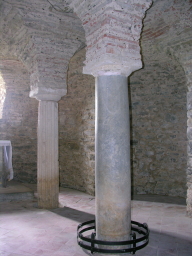
And here the nave (14 metres shorter than built by the founders)
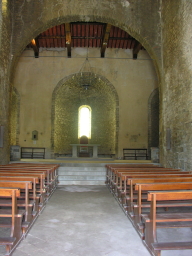
This
abbey was supposedly founded by Charlemagne in 781, to provide
shelter for pilgrims on their way to Rome. The abbey seems to have
got involved in the wars between Siena and its neighbours, and was
suppressed in 1462. Restoration started in 1870 and the abbey is now
home to a community of Norbertines who sing plainchant at Mass every
Sunday. And this is why we were there. The music wasn't bad, but
perhaps not as good as the St Agnes Schola on its good days. 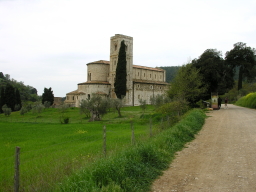
The
village of Castelnuovo dell'Abate - which could well have been the
reason the abbey fell foul of the Sienese. 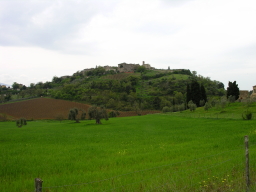
One
of the blank arcades in the facade, carved with the symbols of the
evangelists. 
We
arrived early enough to be able to take our photos before Mass began.
As the guidebook says "The soft, honey coloured alabaster
interior has an odd luminous quality ..." 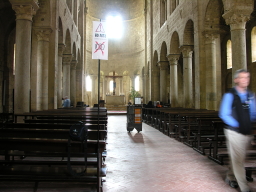
All the more
notable in that it was (as you can see from the outside shots) a very
dull day. 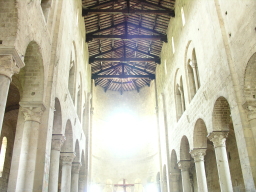
No
mention in any guidebook of this lion.
The
ambulatory around the choir shows the French Cistercian influence
(the current church dates from 1118). 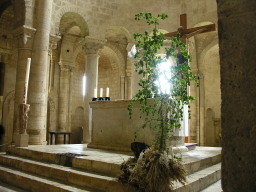
The
crypt is hardly big enough to stand up in (well, Marie-Christine was
OK) 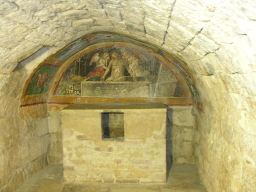
Wall
paintings in the ambulatory 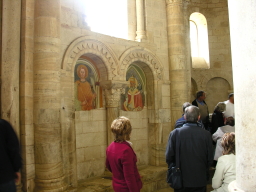
The buildings on
the right hand side of the church were converted into living
accommodation in 1462. This looks as though it was the site of the
old monastery cloister. 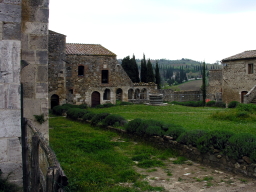
One
last shot of the facade before we go off to find somewhere for our
picnic. 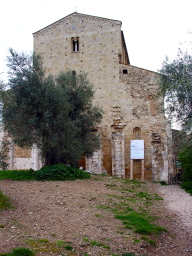
We
couldn't find anywhere to park in Montalcino, so all we saw of the
town was this panorama from the lay-by where we picnicked.. 
Another town we had
never previously visited, and one that did have a car park, was San
Quirico. The local stone is quite golden, rather like Adderbury. 
But
they built the local churches from a whiter variety. This is the
collegiata of Saint Quirico.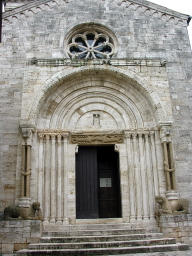
An
altogether less ornate church of Our Lady, to which an absurd 19th
century campanile was an unneccesary "adornment"
Luckily, the interior was sober, by Italian standards. 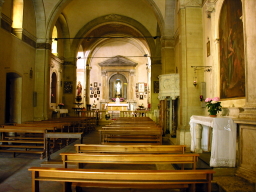
Further
along the main street, another very simple church, S Michele I think
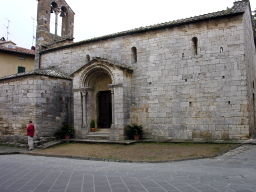
and simple on the inside, too 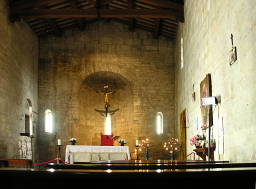
As I had hoped, walking far enough along the main street brought
us to the ramparts, from which it was reasonably easy to find the
place where we had parked. 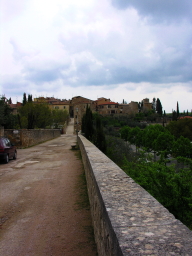
"owes its
fame" says one of my guide books "to the fact that the
Emperor Henry VII of Luxembourg died here on 24 August 1313". I
knew I had heard of it somewhere. Here are the town ramparts,
as one sees them driving through on the Cassia. 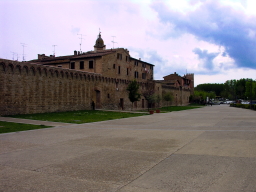
Here
the Palazzo Pretorio, decorated with the coats of arms of several
Sienese and Tuscan officials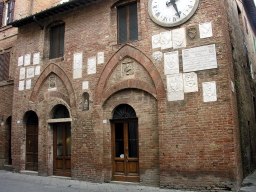
With
streets as narrow as this, it is no surprise bicycles are the
preferred form of transport 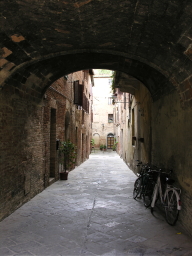
But
it is hard to imagine this as being part of the main road from Siena
to Rome.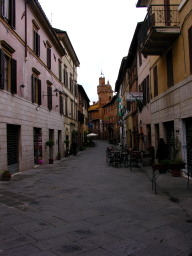
Our
main reason for visiting Volterra was to see the Guarnacci Etruscan
Museum. The cinerary urns were a real revelation. Naturally, no photo
:-((. Our ticket (this was the first time we got reduced price
admission for being pensionati)
entitled us to see the Pinacoteca, where there is a famous Deposition
by Rosso Fiorentino. And the Museo Diocesano dell'Arte Sacra. And
guess what? No photos in either of them. Here, at least, is a link
to an authorised copy of the Fiorentino. the Palazzo dei Priori,
decorated with coats of arms on the right hand side. Supposedly the
model for the Palazzo Vecchio in Florence.
And
here the Palazzo Pretorio, we think. 
Here
the facade of the Duomo, which was shut 
And
here the facade of the Baptistery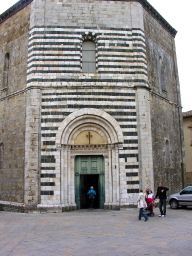
On
our last afternoon in Florence we took the bus up the hill to
Fiesole. The purpose was to get the panoramic view of Florence from
the North that had enthused so many writers. It was the wrong kind of
day for that.
Much too hazy. Still,
you can see that the city hasn't (quite) reached all the way up the
hill. But even with a zoom, it is really hard to make out the
Duomo.
That's OK, Fiesole has its own. 
This is the aisle (of the Fiesole one),which seemed very restrained compared with what goes on down thehill
